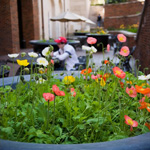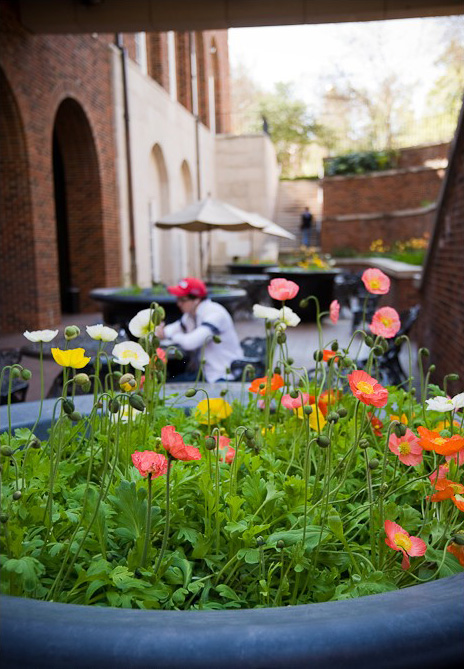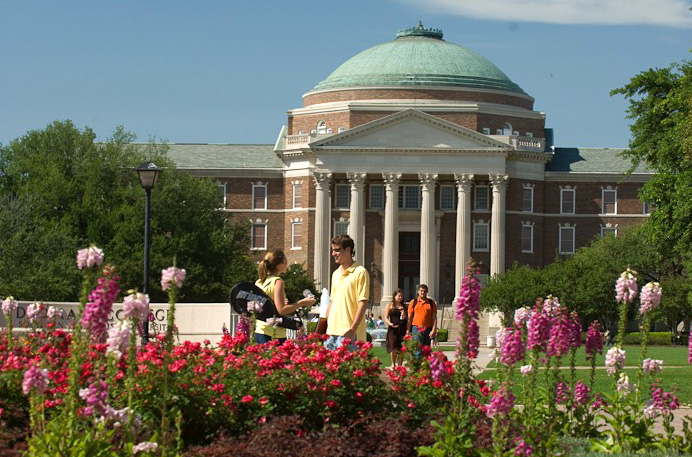SMU Grounds:
A study in extreme weather survival and smart design
You can benefit from what SMU has learned about maintaining a landscape in a drought.

By Denise Gee
SMU News
DALLAS (SMU) — It’s taken 100 years for a cotton field to evolve into a 175-acre urban campus celebrated for arching oaks, beautiful spans of grass, pockets of colorful flowers and sculptural plants.
But in North Texas, extreme weather conditions are the norm. That means keeping SMU’s landscape not only visually engaging, but also alive, is an ongoing challenge, especially now, as much of the nation experiences the worst drought in decades.
 Kevin Dilliard |
“A lot of work goes into what happens here. Not many are aware of that,” says SMU Landscape Manager Kevin Dilliard. “We don’t maintain, we manage.” Of his 18-member team he says, “We’re not a mow and blow operation. Upkeep of our grounds takes much more thought and skill. We’ve set a high standard we intend to keep and even improve upon.”
The payoff is bigger than aesthetics. “When people see what effort SMU puts into maintaining its grounds, they know SMU must be doing that on every level.”
Since Dilliard took the reins nine years ago, SMU has won major awards from the Professional Grounds Management Society during each of its judging periods, competing against top resorts and golf courses. The University also has been featured in leading landscape magazines.
But it’s what goes on behind the scenes that leads SMU’s landscaping work to earn high marks, especially when temperatures can stay in the triple degrees for two months straight during summer and plunge into a deep freeze during winter months—often with as much as a 70-degree temperature swing in a 24-hour period.
Though the summer of 2012 has been a scorcher thus far, with unrelenting high temperatures paired with a lack of rain, “Honestly, what’s more damaging to the campus is when a cold snap happens in winter,” Dilliard says. “I’m from St. Louis and in the Midwest, which is known for its tough winters, there’s at least a slow cool-down that allows plants to be hardened off before the chill sets in.”
To prepare for curve-ball weather conditions, SMU embraces the use of drought-tolerant plants, using more perennials (which come back) than annuals (which need replacing) “and is very selective about what we plant because of water and upkeep requirements,” Dilliard says.

“The weather station saves the University a great deal of time and money,” Dilliard says. “We no longer have to call staff in late at night to come in and shut the system down or make the corrections on overtime. And, we have an Ethernet connection that allows us to monitor it online from anywhere.”
The automated system helps the University save water, but so do landscape team members. A lot of watering is done by hand to get water straight to the roots, where it’s needed most. In addition, two 200-gallon portable tanks at Patterson Hall catch rainwater and condensation from cooling units, storing it as grey water (reclaimed water that’s not potable but is appropriate for landscaping needs).
“Anybody who gardens knows what it takes to keep things looking good, especially at the height of summer and the depths of winter,” Dilliard says. “The biggest task is not only to preserve our resources but also preserve our team. It’s easy to get sick working in such environments. We work to be smart about those efforts as well.”
One misconception is that using drought-tolerant plant material and water-saving techniques means that there’s not much work needed to be done after it’s installed. “It’s really the opposite at the very beginning of installation,” he says. “During the first few years we have to help it get established, and we’ll always have to pull weeds, but over time that will decrease.”

Conservation and sustainability are the focus of current and future endeavors, as is the use of organic products. “We look for every opportunity to use something natural,” he says.
At the heart of every landscaping effort is compatibility with SMU’s distinctive architecture. “That’s what sets us apart,” Dilliard says. “When you are on the SMU campus you know you are at SMU. People always comment on how beautiful the campus is. That’s when we know we’re doing our jobs well.”
Dilliard can be reached at 214-768-3958 or kdilliar@smu.edu.
# # #